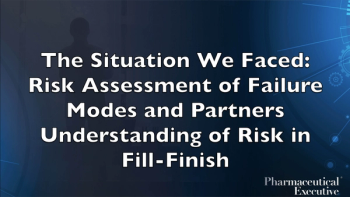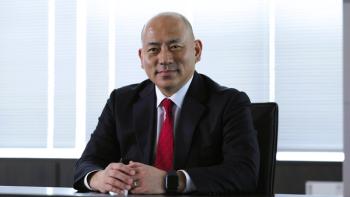
- Pharmaceutical Executive-12-01-2022
- Volume 42
- Issue 12
Business and Passion
Kimberly Moran, head of rare diseases in the US for UCB, started off working in medicine but quickly learned the importance of the business side of industry—and its role in helping improve the diagnosis and access paths for underserved patient segments.
As the US head of rare diseases for UCB in the US, Kimberly Moran has been working in the pharmaceutical industry for nearly two decades and has been a part of UCB for 15 years. During that time, she’s risen through the ranks and held the titles of head of neurology strategy in the US and head of Insights to Impact at UCB. In her current position, she oversees the commercial organization for rare diseases and develops launch strategies for new products in the rare disease market.
Outside of the pharma workplace, she was recognized as a Healthcare Businesswomen’s Association (HBA) rising star in 2018, and the following year, Medical, Marketing & Media placed her on its “40 under 40” list for her work developing UCB’s customer-facing field-market model.
Moran holds a PhD in neuroscience and physiology from New York University and a BS in biochemistry and molecular biology from Penn State University. Early in her career, she learned about the business side of the pharma industry by working alongside leadership at a small, startup company before moving on to UCB. She describes her current role as “a teeter-totter between science and business” that includes working in strategy, lifecycle management, and even sales.
An early calling
Initially, however, Moran had very personal reasons for choosing to work in the life sciences and to focus on rare and orphan diseases.
“My uncle was diagnosed with a rare spinal cord disease when I was only about 10 years old,” she tells Pharm Exec. “Just hearing the complexity of his path and the struggles for someone who is part of only a very small number of people who have that disease, when you have to pioneer to be diagnosed and be treated, motivated me to improve the system.”
Inspired by her uncle, Moran decided that she wanted to focus on rare diseases. She cut her teeth in the pharma industry working on potential treatments for autoimmune conditions lupus nephritis and myasthenia gravis, both considered orphan diseases.
Moran began her career in pharma at Aspreva Pharmaceuticals and credits the experience for guiding the course of her career. The company, which was founded in 2001, was still a startup during her time there. This provided Moran with a unique and wide-ranging training ground.
“The cool part about starting at a tiny startup was that I was employee 36. The head of marketing sat in one office, while the head of medical was nearby, as was the general manager,” she says. “It was interesting because I could learn about investor relations, regulatory, and marketing just by literally walking around the floor of our small company. That really gave me a great lens to understand all facets of pharma and that’s what’s really helped me to build to where I am today.”
One of the most important skills she learned during this time was storytelling. Moran says this helped her bring the science and clinical trial data alive, allowing her to present information in a way where everyone across the company could understand the rare diseases they were working with, even if they were highly complex and technical.
By the time she joined UCB 15 years ago, Moran took her experience working on the medical side and combined it with the lessons she learned on the business side. She explains that early on her career, she noticed that while there were treatments for the rare diseases she was focused on, patients often struggled to receive the proper treatment.
The more Moran learned about the business side, the more she realized that these patients were struggling for a variety of reasons and that there isn’t a one-size-fits-all solution.
“One of the insights that we use is that ‘the system isn’t built for me,’” she says. “The healthcare industry is not the most welcoming and easy thing to interact with, so the more that we can understand the complexity and depth of each patient, we can help them navigate the healthcare system better. They can get diagnosed quicker, treated quicker, and then be on a path to live at their ideals.”
Diversity and digitalization
These pursuits, notes Moran, advance the conversation to two topics that often come up in discussions about improving the modern pharma industry: diversity, equity, and inclusion (DE&I) and digital medicine.
Regarding the latter, Moran describes herself as a “digital evangelist.” According to her, it took pharma a bit longer than other industries to take on digitalization. She explains that pharma is a “data-rich industry” and the amount of data that can be collected, stored, analyzed, and presented using digital tools was “almost too much for us.”
“In the US, you can buy a variety of different types of syndicated data on claims, [electronic health records], and then you layer it with cool things like consumer data. [For example,] I know how many cat lovers are in Brooklyn.” Moran tells Pharm Exec. “We weren’t quite ready to harness that depth in terms of pushing out solutions.”
Fortunately, the life sciences industry has begun to embrace a digital future, much to Moran’s delight. She says digital health tools allow her to use data and information in a much more efficient and powerful way to gain new insights, along with truly understanding the patients and stakeholders that she works with, and creating new solutions.
Moran points out as well that novel innovations in digital health are also helping to find new and harder-to-reach patients. Once again, her specific experience with treating rare diseases helped her search out new approaches, this time by identifying ways that new technologies could be used to track specific symptoms.
“An example is utilizing technology to identify biomarkers for disease progression,” explains Moran. “You can use your iPhone to measure any eyelid movement and voice changes. Those two things are indications of muscle weakness, which are hallmark for myasthenia gravis. We’ve partnered with a variety of tech firms to begin to pioneer, test, and roll out technologies to improve care and address those unmet needs.”
It’s clear that digital health and the possibilities it may unlock excite Moran. She points to the significant amount of practical application digital health is amassing in other industries, and believes those use cases can be adapted to pharma industry efforts in the space.
For example, she discusses the rise of marketing on social media, such as TikTok and Instagram, and how these advertisements can be focused on very specific markets. According to Moran, a similar approach can be taken when trying to identify patients for treatment or potential involvement in clinical trials.
“Some of the work that we’re pioneering is using these novel data sources to find patients and being able to have a new go-to-market model that leverages patient findings so that we are bringing solutions to patients much quicker than they would have in a non-digital supported ecosystem,” she says.
Not surprisingly, Moran’s interest in improving ways that pharma organizations find new patients extends to her views on the importance of DE&I. On its website, UCB describes Moran as a catalyst for change at the company when it comes to diversity. She was part of a team of employees who advocated for a DE&I council, along with a full-time diversity lead for the US.
When it comes to DE&I in the life sciences industry, Moran describes it as “essential,” especially in the context of patients and enrolling participants in clinical trials.
“Your patient populations need to reflect the land that each of these individuals are living in,” she stresses. “If you’re at the southern border of the US, it’s often Latinx and Spanish speaking patients. If you’re up in New York, you can roll the dice of 126 different countries that individuals may be from.” Moran also believes that rare diseases offer another look into the social determinants of health.
One of the problems that Moran wants to solve is the way that the healthcare system interacts with low-income populations. Part of her approach to fixing this issue is a push to include patients from these segments in clinical trials, to ensure that their needs are identified and addressed by the drug.
Challenging those pursuits, Moran notes, is how people from lower economic populations seem to be wary of the healthcare system, either out of fear or distrust. She says this can be another barrier to these patients participating in clinical trials, and it’s why she’s put significant focus on educating patients from these traditionally underserved populations. Her goal is to ensure that the clinical trials that she’s involved with truly represent the population of people who are actually living with thee disease or condition being worked on.
When asked about the struggles she’s faced navigating these challenges, Moran offers this advice: “It’s making sure that you slow down to go fast. It’s so easy just making sure that you get as many patients as possible so you can get your solutions out there,” she says. “You also must think, however, about onboarding a site in a neighborhood you haven’t done so in before. Maybe the doctors and [healthcare professionals] in that area haven’t run a clinical trial, so you might have to give them extra time to start up and be ready to do enrollment. They may need extra support in terms of having the right clinical trial coordinators and folks that can really be where patients are, that can show the right balance of demographics so that we have the data and information for folks with these diseases. Since the diseases I’m working on are rare, or even ultra-rare, it’s super hard to find patients for these clinical trials.”
No small feat
It’s the unique challenges like these, inherent in rare disease R&D, that Moran has spent her career trying to overcome.
For example, she says that one of the diseases that she’s working on currently only has about 300 patients living with the disease. These small populations obviously makes it hard to recruit people for trials. Other conditions that she works on may ultimately have more patients, but many are often undiagnosed. This means that her UCB team has to rely on genetic testing, data, and analytic approaches to identify patients for some of these trials.
This further weaves in Moran’s fascination with digital health, which has pioneered the identification of genetic biomarkers, for example. These biomarkers allow researchers to identify patients who are still in the early stages of disease progression and haven’t been diagnosed yet, or are likely to develop the condition later in life.
While digital technologies have helped support her work, Moran is also mindful that not everyone is willing to embrace digital health, including some patients.
“It’s a double-edged sword. You must be tailored and customized, and your tools have to flex based on the patient preference,” she tells Pharm Exec. That’s something that we’re learning in terms of designing patient solutions. Some folks want some SMS or text, some would like an email or a website. Then there’s some that don’t have access to technology and a paper enrollment form is what they’re looking for.”
While balancing these varied preferences, Moran says it’s important to use tools in digital health to help close the knowledge gaps in current treatment vs. right treatment, or patients being diagnosed or not. She believes there are many solutions drugmakers and their partners can tap into to close those gaps.
As an industry, pharma can’t do things alone,” says Moran. “When it’s around direct care delivery, there’s a pretty big distrust of pharma coming in with altruistic/holistic solutions, so you need to partner with patient organizations or tech companies.”
UCB, for example, has a collaboration with Microsoft around drug discovery and development, and, according to Moran, also works closely with patient organizations and patient advocacy groups. “Partnership is one of the key levers to the future, especially in rare diseases,” she says. “These aren’t disease states where you can just own a section, you have to lean in and go with the holistic disease. That’s a big area for me.”
Moran’s career may have started on the science and medicine side of the industry, but it has been her ability to merge those aspects with the critical business execution necessary to advance rare disease research that has ultimately shaped her success.
Mike Hollan is Pharm Exec’s editor and can be reached at
Articles in this issue
about 3 years ago
2023 Pipeline Report: Testing the Limitsabout 3 years ago
Back in Person, Sparks Could Fly at Upcoming J.P. Morgan Conferenceabout 3 years ago
Aligning Trust and Transparency in Brand Messagingabout 3 years ago
Pharma Needs to Look Internally for New Leadershipabout 3 years ago
Seeking Concrete Solutions to Europe’s Supply Problemsabout 3 years ago
Pandemic and Politics Shaped Pharma and FDA in 2022about 3 years ago
Medical Affairs Uptickabout 3 years ago
Pharmaceutical Executive, December 2022 Issue (PDF)about 3 years ago
Virtual Medical Affairs Audits: A Viable AlternativeNewsletter
Lead with insight with the Pharmaceutical Executive newsletter, featuring strategic analysis, leadership trends, and market intelligence for biopharma decision-makers.




